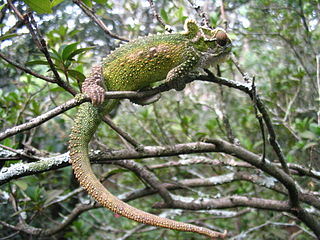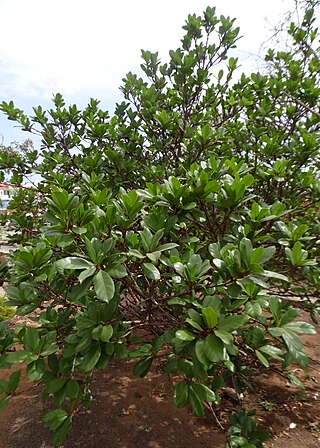
Bradypodion is a genus of chameleons in the family Chamaeleonidae, collectively called South African dwarf chameleons. All species are found in South Africa and most are endemic to this country, but a few can also be found in Eswatini, Lesotho, southernmost Namibia and possibly southernmost Mozambique. They are quite small chameleons where the different species often can be difficult to separate by appearance, although exact location and the intense breeding colours of males are useful for their identification. They are arboreal, but some species are mostly found low in the vegetation.

Rhampholeon is a genus of small chameleons, commonly known as pygmy chameleons or African leaf chameleons, found in East Africa and Central Africa. They are found in forests, woodlands, thickets, and savanna, and most species are restricted to highlands. They are brown, grey, or green, and typically seen at low levels in bushes, or on the ground among grasses or leaf litter.

Kinyongia is a genus of chameleons found in montane and sub-montane areas in Kenya, Tanzania, Uganda, Rwanda, Burundi, and far eastern DR Congo. They are restricted to forests, woodlands and other wooded habitats, and many species have very small geographic ranges. In most species, at least the males have horns or knobs on their noses. As typical of most chameleons, Kinyongia are oviparous.

Currently, two species are placed in the recently established genus Nadzikambia. They are plesiomorphic, small chameleons from the Ruo Gorge forest on Mount Mulanje in Malawi and Mount Mabu in Mozambique.

Mount Namuli is the second highest mountain in Mozambique and the highest in the Province of Zambezia. It is 2,420 m (7,940 ft) high and was measured, surveyed and described in 1886 by Henry Edward O'Neill, the British consul in Mozambique. The Namuli massif consists of a level plateau with the granite dome of Mount Namuli above. The area was historically clad in tropical rainforest and is an important biodiversity hotspot with many endemic species of animals and plants. The lower slopes are now mainly used for the cultivation of tea and the middle slopes for other agricultural purposes, with indigenous forest now mostly restricted to the higher parts and corridors along water courses.

The Southern Zanzibar–Inhambane coastal forest mosaic, also known as the Southern Swahili coastal forests and woodlands, is a tropical moist broadleaf forest ecoregion of eastern Africa. It is a southern variation of Northern Zanzibar-Inhambane coastal forest mosaic. The ecoregion supports habitats of forest, savanna and swamps. The southern portion of the ecoregion is not as well studied due to the 1977-1992 civil war in Mozambique.
Atheris mabuensis, the Mount Mabu forest viper, is a species of venomous snake in the family Viperidae. The species is endemic to Mozambique.

Helixanthera schizocalyx is a species of loranth, or tropical mistletoe, discovered by a research team from Royal Botanic Gardens, Kew on Mount Mabu in northern Mozambique in 2008. In December 2010, it was announced that it was a new discovery and determined to be vulnerable to extinction.

The Natal Midlands dwarf chameleon is a chameleon native to woodland habitat in the inland Midlands area of the South African province of KwaZulu-Natal.
Kinyongia carpenteri, commonly called Carpenter's chameleon or the helmeted chameleon, is a species of chameleon, a lizard in the family Chamaeleonidae. The species is native to central Africa.

The Mlanje Mountain chameleon is one of two species in the genus Nadzikambia. It is a plesiomorphic, small chameleon from the Ruo Gorge forest on Mount Mulanje in Malawi.

The Mount Mabu chameleon is one of two species in the genus Nadzikambia. It is a small chameleon from Mount Mabu in Mozambique.

''Ficus cyathistipula'', the African fig tree, is a species of fig that is native to the tropical forest regions of Africa. They may be small trees, shrubs or hemi-epiphytic lianas, and are widespread in the moist tropics, where they may be found in Afromontane or rainforest, often overhanging pools. The figs are reddish when ripe, and have thick, spongy walls that enable them to float on water. They are named for their cup-shaped (cyathus-) and persistent stipules (stipula).

Mount Lico is an inselberg mountain in the Alto Molocue District of Zambezia Province in northern Mozambique, most notable for its old-growth rainforest and its lack of penetration by humans. Mount Lico is approximately 1,100 metres above sea level but is distinctive in having sheer rock walls of up to 700 metres above the surrounding countryside that have all but prevented human intrusion. The forest on top, within a volcanic crater, covers only about 30 hectares.
Rhampholeon bruessoworum, the Mount Inago pygmy chameleon, is a small species of chameleon endemic to Mozambique. It was described in 2014.
The Mount Mabu horseshoe bat is a species of horseshoe bat that is endemic to the Southeast African nation of Mozambique.
Mount Inago, also known as Serra Inago, is a mountain in northern Mozambique.
Roeperocharis bennettiana is a terrestrial orchid native of East Africa. It is one of the 4 known species of the genus Roeperocharis as of 2014. This species of orchid has been reported to grow on woodland, Mbuga and grassland vegetations.

Rhampholeon maspictus, the Mount Mabu pygmy chameleon, is a small native species of chameleon endemic to the tropical rainforests atop Mount Mabu in Zambezia, Mozambique. It is roughly 6 cm (2.4 in) long.












